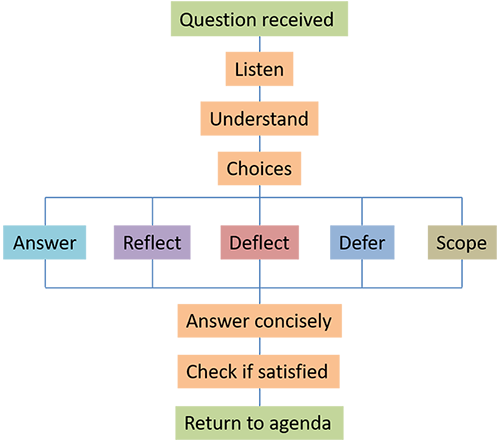Guide for Handling Questions after a Presentation
October 19, 2017 - Dom Barnard
The questions at the end of a presentation can be terrifying for many speakers as they can’t be controlled and are hard to prepare for. However, questions form an important part of the presentation for the whole audience as they allow for clarification and consolidation of learning.
The presenter can enhance the usefulness of the question and answer session by treating it as a formal part of the presentation that requires as much careful planning and control as the delivery of the core material.
Identify possible questions and scope in your preparation
The background work that you undertook whilst planning your presentation is the key to handling questions effectively and understanding what type of audience you'll be faced with. If you have defined a focus for your presentation and have explored this thoroughly in your research and planning, you are more likely to be able to confidently respond to questions.
When planning your presentation, you will need to prepare prompts for questions that are open and straightforward, for example saying “That’s the end of my presentation. I’ll be taking questions for the next 10 minutes”.
You might also want to define topics for discussion before taking questions, by stating the areas you’re willing to field questions in. Your preparation will help you identify topics you are not confident with and want to avoid in the questioning.

Set some rules for asking questions
At the start of your presentation, make it clear when you would prefer to deal with questions - as you go along or at the end of the presentation.
Some speakers prefer questions to be raised as they arise during the presentation. The advantage of this approach is that any misunderstandings can be dealt with immediately. However, there is also a danger that the question will disrupt or distract the speaker, or that questions are raised that would have been covered later in the presentation.
If you leave questions until the end, plan to leave plenty of time for questions so that the audience doesn’t feel rushed.
Framework for responding to questions
Answering questions under pressure can make you say things you shouldn’t have - the nerves can force you to give an inappropriate response. In your panic you might have misinterpreted the question or given away company information that was sensitive. Use the following framework to help you respond effectively to your audience.
Practice answering AI-generated questions on your speech or presentation with VirtualSpeech.
1. Listen to the whole question
You don’t have to answer a question immediately. Pause for a few seconds, actively listen to all parts of the question and think about the best way to answer.
Frequently questions can change direction at the last moment, particularly if the questioner is thinking on their feet. This can throw you if you have already started to prepare an answer. Remember that questioners will frequently try to make a point whilst asking their question – it’s therefore important to both hear the content of the question and try to decipher the questioner’s intention.
2. Understand the context
If you are worried that you haven’t understood a question, ask them to clarify what they mean. Check for confirmation by paraphrasing the question back to the questioner - “You want me to list the improvements of X?”.
3. Involve the whole audience
It is important to remember that even though you are taking a question from one member of the audience, you are still responsible for the interest of the other audience members. This is particularly important in large groups as the audience will become bored if the presentation descends into a series of one-to-one discussions.
To involve the rest of the audience, make sure the whole audience has heard and understood the question by repeating it or paraphrasing it to the audience.
4. Respond concisely
When you reply to a question, direct your answer to both the questioner and other members of the audience. Try to keep your responses as focused as possible, leaving space for other questions. To avoid going into too much detail, check back with the questioner to see if you have answered their query – “Does that answer your question in enough detail?”.
We’ll cover different ways to respond in a later section.
5. Allow follow-up questions via email
You can also encourage your audience to ask questions after the event has finished by providing your email address. This shows a high level of respect for your audience and implies that the topic still has much further scope for enquiry.
Two good resources for handling questions
Practice Answering Questions
Practice answering questions after your presentation using a 4 step process.
Learn MoreOptions for answering the question
There are five possible choices depending on how well you understand and can answer the question. It’s okay to say that you don’t know the answer to something. This can add to your credibility instead of trying to waffle through an answer you don’t really know.
Answer
If you have a good answer for the question from the audience, go ahead and answer it in a short and clear message.
Reflect
Ask a question back the audience member, such as “Can you clarify what you mean by that”. You can also attack the question if it is not related to the issue, factually inaccurate, personal or based on false assumptions. Be careful with this method.
Deflect
Ask the question back to the audience or pass it to another panel member if possible. If suitable, another technique is to imply the question has been asked already, with you stating you don’t want to cover old ground.
Defer
Tell the audience member you will talk to them after the event. This gives you more time to think of a good answer and there is less pressure to give a perfect answer.
Or mention that that point is coming up in a slide.
Scope
This involves answering the question but changing the subject. You can also give a partial answer or give a negative answer, saying that something else will happen instead.
Avoid answering questions that fall outside of the remit of your talk: “I’m afraid that really falls outside of my objectives for today’s presentation. Perhaps we can resume discussion of that particular point later?”

Diagram Explained: Once you receive a question, you’ll have a few moments to think about it and reframe it in a way that makes sense to you. This will give you five choices on how to react - you can answer, reflect, deflect, defer or change the scope of the question. Once you’ve answered concisely, you can then follow up to check if the person asking the question is satisfied and then continue with the presentation.
Strategies to use when struggling to answer
Here are some strategies to use when you are struggling to answer the question posed to you. For more information, read this article on Dodging the Question.
- Acknowledge the question without answering it - "That’s a good question, let’s consider the impact by looking at..."
-
Attack the question, on the basis of:
- The question fails to tackle the important issue.
- The question is based on a false assumption.
- The question is factually inaccurate.
- The question is too personal or objectionable.
- Decline to answer. Refuse to answer on the basis that it is not your area of responsibility or it is sensitive company information - "You will have to ask [name] because I wasn’t involved in that particular project."
-
Give an incomplete answer
- Partial answer
- Start to answer but change the subject
- Negative answer. You state what won’t happen instead of what will happen
- Answer a similar question
- State or imply the question has already been answered - "We’ve already covered that topic"
Things to avoid
When handling questions and answers, you will still need to be as professional as you have been for the main delivery of your presentation. There are some common dangers to avoid.
Answering the question you wished you’d been asked
A common trick played by politicians, this strategy ignores the precise nature of the question and uses a predetermined answer to the broad topic area. If handled poorly, this technique is very obvious to the audience and frustrating to the questioner.
Giving a lengthy response
This is the process whereby you make a lengthy response, including all the information you’d left out in planning the main presentation. Your unplanned response will be unstructured and rambling, so keep things focused and brief. If you find yourself rambling, ask them to talk to you after.

Passing the blame
Passing the blame to others comes across as weak and evasive. If an idea from the audience is a good one, acknowledge its value. If it isn’t, make a polite rebuttal and move on.
Defensive answers
Occasionally, questions can really put you on the spot, but it is important to remain calm and in control. An aggressive or defensive reply will be seen as weakness on your part and will spoil the effect of an otherwise successful presentation.
Handling difficult questions
It is important not to start responding to a difficult question before you have thought about the answer. Repeating the question and asking for clarification will help create some space for your thoughts.
Sometimes you will need to think about a question for a moment before responding. You may be able to buy a little bit of thinking time to help focus your response. Useful strategies include searching for an appropriate visual aid to help focus your response or simply pausing for a moment or two to think. For even more time, suggest that you’ll come back to the topic later (but don’t forget to do this).
Practice Answering Questions
Practice answering questions after your presentation using a 4 step process.
Learn More7 myths when answering tough questions during presentations
Sometimes questions are too difficult to answer. Don’t worry about admitting that you don’t know something or haven’t considered an alternative approach. An enthusiastic “That’s an interesting idea, I’d not thought of that” is much more positive than a mumbled “I don’t know ”. Remember that a presentation is a two-way process and it is important to show that you are learning from your audience as well.
Finally, you can come across a questioner who disagrees strongly with your argument. Although this can feel very awkward, remember that you are still responsible for the whole audience and that you cannot allocate all of your question time to one individual.
If you feel that you have answered the initial question, announce that you will move on and suggest that you might continue discussion after the presentation. If the questioner persists, assert your position calmly by saying “I’m afraid I need to move on”.
You can read more on this topic here: Responding to questions effectively (PDF)


